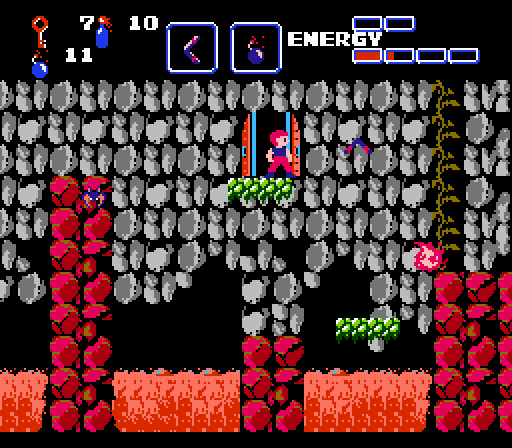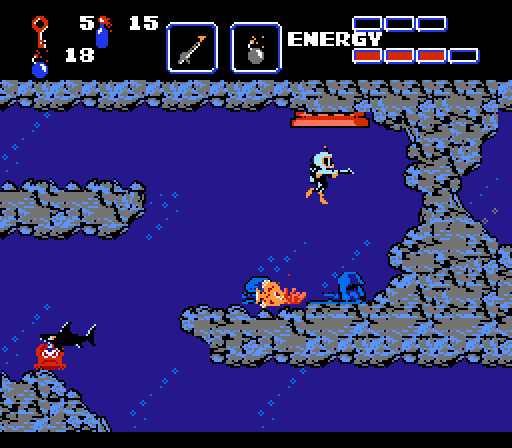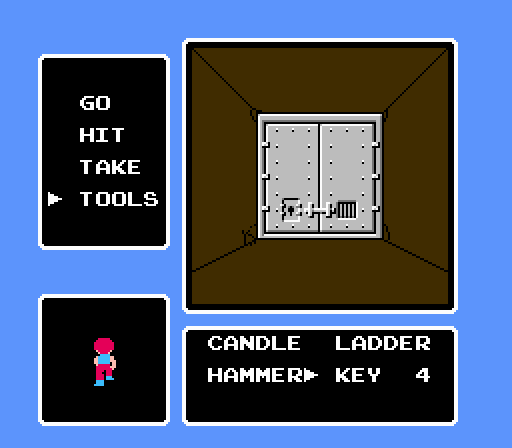Like so many video games, The Goonies II presents some strong ideas and solid moments… and it ends pretty terribly. The game sort of peters out, losing its momentum in the final stretch.
Quite possibly the strangest portion of the game comes in this final zone, a completely unique tile and palette set that comprises all of nine screens worth of the game world. On the map, it’s the tiny little curlicue on the bottom-right of the Back map, and it exists only one one side of the world — there’s no Front-side equivalent here. This area has only a handful of doors to explore, and you can cruise through this portion of the adventure in a matter of minutes.
Given the tight memory constraints of NES carts of this era, the addition of such a small, unique zone seems almost wasteful. It’s over before you even can really appreciate it, and then you’re back to more attics and cellars — the same couple of tile sets arranged in different color sets, though similar enough colors to be fairly confusing.
At this point any adherence to the movie is pretty much out the window. You could kind of see the Goonies film connection in things like skeletons and knights, given the dead pirates and museum curios in the movie, but fire-breathing dragons over open pits of magma that spew gouts of flame? You can see Konami pretty much laying down the template for a decade of sketchy licensed adaptations. “Well, we’re out of ideas that look like the actual flick, so, eh, what the hell.”
The hazards in this zone hit unbelievably hard; the dragons take something like a dozen hits to put down, while they shave an entire block off Mikey’s health with a mere touch. Those fireballs, which have a tendency to blast into you while you’re trapped on a lift, are nearly as dangerous.
Still, even if it’s horribly out of place and lopsidedly difficult, the fire zone has a certain charm to it. Visually, it’s quite appealing, with the bright green dragons popping out against the rich earth tones and deep neutrals of the caverns. And gosh darn it if those critters don’t look downright delighted to be frying Mikey’s face with searing gouts of superheated air.
As it turns out, I was mistaken about being forced to reach the fire zone by traversing the bridge. As it happens, you can get there two different ways: Through the geyser caves, yes, but also by way of a Warp Zone in the Back portion of the opening stage, where the first Goonie was trapped. So there’s no need to risk life and limb and boomerang on the bridge; whatever time you might be able to shave off your run by going from the ice caves to the cavern across the bridge is negligible and certainly not worth the risk of losing your hard-fought boomerang, which you desperately need against the powerful creatures in the latter stages.
The far end of the magma caverns takes you to another Warp Zone that leads into the most advanced area of the Fratelli hideout. Although it looks similar to the attics above the Front portion of the hideout, the main difference comes in the enemies: The Knights here use short sabers and small round shields, and the skeletons are a weaker variant with hunched posture.
Given the visual repetition here, much of the difficult in the quest for the final Goonie comes from the simple act of keeping track of where you’ve been already. It’s easy to get lost thanks to the reuse of assets, and while this one green-tinted version of the attic definitely stands out, the others (all in tan and orange) blend together. And it doesn’t get any easier once you descend into the cellars for this portion of the map, which appear in slightly different shades of orange.
In any case, it’s worth searching until you find the last key item of the game: The optional but extremely useful Bulletproof Vest, which reduces damage to Mikey by 1/2. This greatly increases his survivability, which is important despite the mild penalty for continuing: The final two hostages to rescue are secured in areas where weak, easily defeated enemies are less common than more durable monsters, so grinding for Keys can be a hassle. Better not to wipe out and lose all your Keys in the first place.
Surprisingly, there’s one last underwater section, though it’s small: A simple two-screen sequence where a Goonie is held captive. It feels like this portion of the game was designed to be annoying; the pipe here deposits you in an area where Mikey can’t help but bump his head on the ceiling and immediately rebound back into the pipe. It’s a small detail, but one that suggests the designers weren’t really paying much attention at this point in the game.
With all six Goonies safe, Mikey can venture through the Warp Zone in the Front area of the initial hideout. Annoyingly, there’s no short route from the sixth Goonie to the beginning; you need to backtrack all the way through the confusing attics and dangerous fire caves. Alternately, you can sacrifice Mikey, jot down the password, and choose to continue the game. You’ll restart from the beginning, a few screens over from the Warp Zone leading to the final run. When accepting a game over is your most efficient path forward, you’ve probably done a lousy job of designing your game.
Also, props to the inclusion of one last unique background tile set, though using it to depict yet another cabin/attic-type space seems a bit of a waste.
The final run is actually fairly straightforward — if you head right every time you enter a new area and take the first door you encounter, you’ll reach Annie in short order. Finally, it comes down to this twisting screen full of mundane enemies you’ve been fighting throughout the game. None of the weird end-game monsters show up here — the lumbering golems or sword-wielding skeletons or bizarre ghost that warps in from all corners of the screen to center on Mikey’s current position. Nope, just some anticlimactic snakes and spiders.
Which in turn leads to that last underwater door and a massive steel gate that only opens if you’ve saved all six Goonies.
Inside is your inexplicable damsel-in-distress, Annie the Mermaid, who greets you enthusiastically. This whole thing is weird: Why a mermaid? Why did they base her name and appearance on Little Orphan Annie? Also, I didn’t think anything of it when I first played this game at age 13, but now that I’m much older I’m a little uncomfortable about the princess at the end of the proverbial castle being a nude underaged girl.
All in all, a fairly bizarre mix of the movie’s concepts with the developing tropes of video game design and storytelling.
I have to imagine that for those who have never played The Goonies II, discovering and playing it for the first time today must feel an awful lot like the way I feel when I try and boot up a old Spectrum game whose praises I hear trumpeted on high. I can sense the underlying ambition and innovation that resonated with people several decades ago, but it’s so opaque and unfriendly I can’t lose myself in it the way its contemporary fans did.
I will say, though, that The Goonies II has one advantage over most Spectrum games: It’s not ludicrously difficult. The defanged penalties for dying and infinite continues might undermine its appeal for some, but this would be a considerably lesser game experience if you had to play it through in one sitting, or even on one credit. It’s every bit as unfair in places as something like Jet Set Willy, with powerful enemies placed for maximum cheap hits, but you can keep hammering away at it until you finish. Flawed, but well-meaning, and an important albeit halting step toward greater things.











I went back and played the Goonies II shortly after you began the Anatomy of it. I gave it about 4 hours before I decided I didn’t have the nostalgia-fueled resolve to continue. The main issues I found were the boring adventure scenes where you are just tapping walls over and over to make sure you didn’t miss something and the level layouts being very confusing. More than once I found myself going in circles to try and find a previously visited adventure scene door that required a newly acquired item.
It is kind of sad, because, as you said, there are a lot of good intentions and interestingly obtuse elements that make the game feel like a lighthearted adventure with a loose tie to a lighthearted movie. It is the kind of game that could easily be revisited with contemporary designer’s eyes and made into a great little adventure game. Honestly, the Goonies tie-in isn’t really that important.
Out of curiosity, did your jetpack idea include the Goonies concept or was it just a fun adventure game with a similar setting as the game? And has this Anatomy influenced what you wanted to make?
That is CLEARLY Clark Kent reporting on the arrest of the Fratellis at the end of the game. Look at the “S” curl!
I thought so too, but on closer examination he looks fairly Japanese. So Clark Kobayashi, maybe?
I’ve never played this game all the way through (never really made it past the opening areas, in fact), so while reading this I was hoping to see where you wanted to have the jetpack. The bridge?
Thank you for taking the time to explore this game. I used to hate it as a child because I couldn’t figure out how to progress, but I gained more appreciation for it after revisiting it as an adult, in spite of its flaws.
The Game Grumps did a pretty entertaining run of Goonies 2! https://www.youtube.com/watch?v=TFJHqG6DG0U
I played through this game for the first time a few summers ago (I played through a repro cartridge of the first game the Christmas before) and I enjoyed it. It probably helps that I wisely printed out a map of the game beforehand, but even then I still found myself lost quite a few times, having to reference GameFAQs to regain my bearings. A few tweaks here and there (and possibly the removal of the first person maze segments) and it could’ve been a classic alongside Metroid (which, in all honesty, also had its issues).
In the end, I’m glad I played it through to the end, though I have no desire to play it again. If they ever do make a sequel to the Goonies movie, they should totally base it on this game… maybe minus the topless underage mermaid, of course.